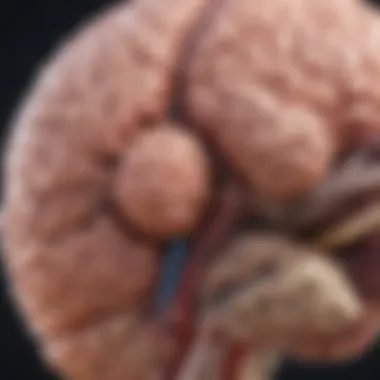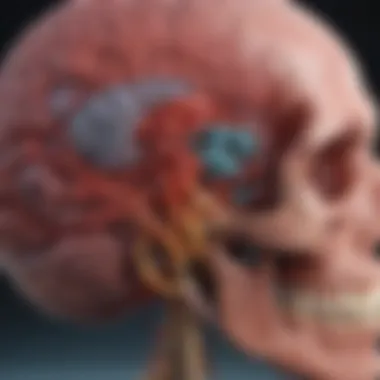Non-Traumatic Intracerebral Hemorrhage: A Comprehensive Guide


Intro
Non-traumatic intracerebral hemorrhage (ICH) presents significant challenges in the field of neurology. The implications of this condition not only affect individual patients but also strain healthcare systems. By understanding the causes and management of ICH, medical professionals can enhance patient outcomes and improve resource allocation. This article aims to provide a cohesive and detailed examination of the subject, fostering a better understanding among students, researchers, and practitioners.
Research Overview
The investigation of non-traumatic ICH is characterized by a diverse array of methodological approaches. Clinical studies often focus on epidemiological data to identify risk factors and potential triggers for this condition. Furthermore, neurological assessments are crucial for timely diagnosis and treatment.
Methodological Approaches
Research studies typically employ both retrospective and prospective designs to gather data on non-traumatic ICH. This dual approach facilitates a comprehensive analysis of patient histories, revealing patterns that assist in identifying at-risk populations. Advanced imaging techniques, such as magnetic resonance imaging (MRI) and computed tomography (CT), play an essential role in establishing a quick and accurate diagnosis of hemorrhages.
Significance and Implications
Understanding the causes and management strategies for non-traumatic ICH is pivotal. The implications extend beyond immediate clinical outcomes, affecting long-term health trajectories for patients. Rapid intervention is often linked to improved recovery rates, making accurate diagnosis essential. The findings from ongoing research enhance our ability to make evidence-based decisions, ultimately lowering the burden of this serious condition on healthcare providers.
Current Trends in Science
There is a growing focus on innovative techniques and interdisciplinary connections in the management of non-traumatic ICH.
Innovative Techniques and Tools
Recent advancements in medical technology contribute significantly to the diagnosis and management of intracerebral hemorrhages. Techniques such as endovascular therapy and minimally invasive surgery are explored for their potential to improve outcomes. These methods present opportunities for better recovery, reducing the need for extensive rehabilitation.
Interdisciplinary Connections
Collaboration across disciplines, including radiology, neurology, and rehabilitation medicine, is vital for a comprehensive approach to non-traumatic ICH. Healthcare professionals must communicate effectively to ensure cohesive treatment plans that address both the immediate and long-term needs of patients.
"Timely and effective treatment is critical in neurological emergencies like non-traumatic ICH. Scrutinizing traditional practices and integrating innovative solutions can lead to breakthroughs in patient care."
In summary, non-traumatic intracerebral hemorrhage is a complex condition requiring multidisciplinary approaches to improve patient outcomes. The ongoing research and trends in science highlight the need for novel strategies and collaborative efforts to address the challenges posed by this serious medical condition.
Prelude to Non-Traumatic Intracerebral Hemorrhage
Non-traumatic intracerebral hemorrhage (ICH) represents a significant medical condition with serious implications. Understanding its nature is vital for both healthcare professionals and laypersons. The focus of this article is to dissect the intricacies surrounding ICH, offering insights into its causes, clinical implications, and the methods for managing it effectively. Awareness of ICH’s complexity can lead to improved patient outcomes and community education on stroke prevention and care.
Definition and Overview
Non-traumatic intracerebral hemorrhage refers to bleeding within the brain tissue itself without a clear external injury. This condition generally occurs due to the rupture of blood vessels, often exacerbated by underlying health issues such as hypertension. It can lead to detrimental effects on brain function.
The mechanisms behind ICH can be multifactorial, including vascular malformations, blood disorders, or the influence of anticoagulant medications. Thus, accurate diagnosis and prompt treatment are crucial to minimize potential brain damage and maximize recovery potential.
Importance in Clinical Medicine
The study of non-traumatic ICH is essential in clinical medicine for several reasons. First, it highlights critical risk factors that can lead to serious morbidity and mortality. Conditions such as hypertension and the presence of cerebral aneurysms are often at play. Recognizing these risks allows medical professionals to implement preventive strategies effectively.
Second, the management of ICH can influence not just acute care but also long-term rehabilitation strategies. Understanding the various treatment options, including surgical and medical therapies, is crucial for tailoring approaches to individual patient needs.
Lastly, increasing awareness of ICH within clinical practice fosters a proactive approach in healthcare settings. Training personnel to recognize symptoms quickly can aid in rapid intervention, significantly improving patient outcomes.
"Timely medical intervention can alter the course of recovery, making knowledge of ICH essential for all healthcare providers."
The discussion will shape our understanding of the condition, ultimately empowering both patients and healthcare professionals in dealing with this potentially life-threatening issue.
Pathophysiology of Intracerebral Hemorrhage
The pathophysiology of intracerebral hemorrhage (ICH) is a critical component in understanding this medical condition. It underpins the mechanisms that lead to bleeding within the brain and its subsequent effects on neural function. Grasping these principles allows clinicians and researchers to develop effective prevention strategies and treatment interventions.


Mechanisms Leading to Hemorrhage
There are several mechanisms that can precipitate a non-traumatic intracerebral hemorrhage. These mechanisms are often interlinked and contribute to the rupture of blood vessels in the brain.
- Hypertension: Chronic high blood pressure can lead to the weakening of blood vessel walls. When vessels rupture, it can cause significant bleeding.
- Cerebral Aneurysms: Abnormal bulges in the blood vessel walls can rupture, leading to hemorrhagic events. Risk factors include genetics and other vascular diseases.
- Cerebral Amyloid Angiopathy: This condition involves deposits of amyloid protein in the blood vessel walls, making them fragile and prone to rupture, particularly in older adults.
- Arteriovenous Malformations (AVMs): These are abnormal connections between arteries and veins that can give rise to hemorrhages if they rupture.
Medical professionals need to be vigilant in recognizing these mechanisms, as they can guide diagnostic and treatment plans. Understanding the pathophysiology facilitates targeted interventions, improving patient outcomes.
Impact on Brain Function
The consequences of an ICH can significantly impair brain functions, sometimes leading to lasting neurological deficits.
- Increased Intracranial Pressure: The accumulation of blood in the brain leads to swelling. This pressure can affect blood flow to other areas, causing further damage.
- Localized Damage: The area of bleeding can become deprived of oxygen, leading to cell death. This may result in loss of specific functions associated with that brain region, such as motor skills or cognitive abilities.
- Inflammatory Response: Bleeding can trigger an inflammatory response in the brain, which can exacerbate damage through vasogenic edema and disruption of the blood-brain barrier.
It is crucial to understand that the pathophysiological changes resulting from ICH are complex and multidimensional. The relationship between bleeding, pressure alterations, and brain response is vital for effective management and rehabilitation.
Overall, a deep understanding of the pathophysiology of ICH is essential for timely and appropriate medical response. It informs both acute management strategies and long-term rehabilitation efforts, aiming to maximize recovery for affected patients.
Risk Factors Associated with Non-Traumatic ICH
Understanding the risk factors associated with non-traumatic intracerebral hemorrhage (ICH) is crucial. This knowledge plays a significant role in prevention and management. Identifying these factors can lead to timely interventions, potentially saving lives and reducing long-term complications. Each risk factor offers insights into underlying health conditions that may predispose individuals to hemorrhagic events. This section explores key elements that contribute to the risk of ICH, facilitating a comprehensive understanding of this serious health issue.
Hypertensive Crisis
Hypertensive crisis is one of the most significant risk factors for non-traumatic ICH. High blood pressure can lead to weakened blood vessels in the brain, increasing the likelihood of rupture. When blood pressure rises suddenly, it can create a life-threatening situation.
Considerations include:
- Monitoring: Regular blood pressure checks can help manage and identify hypertension.
- Lifestyle Changes: Diet, exercise, and medication adherence are critical for those at risk.
- Immediate Response: Recognizing symptoms of hypertensive crisis, such as severe headache or confusion, can facilitate quick medical attention.
Cerebral Aneurysms and Vascular Malformations
Cerebral aneurysms and vascular malformations represent another major risk factor. An aneurysm is a bulge in a blood vessel, which can burst and lead to hemorrhage. Vascular malformations, such as arteriovenous malformations, can also increase the risk of bleeding.
"Understanding the nature of these abnormalities can guide clinicians in managing patients effectively."
Factors to consider:
- Screening: Patients with a family history or symptoms may benefit from imaging studies.
- Surgical Management: In some cases, surgical intervention might be necessary to prevent rupture.
Anticoagulant and Antiplatelet Use
The use of anticoagulant and antiplatelet medications significantly elevates the risk of ICH. These drugs, commonly prescribed for cardioprotection, can lead to uncontrollable bleeding in the event of a hemorrhage. The balance between preventing clotting and risk of bleeding is delicate.
Key points include:
- Risk Assessment: Patients should undergo thorough evaluations before starting such treatments.
- Education: Understanding the signs of bleeding can enhance patient safety.
- Regular Reviews: Healthcare providers should regularly reassess the need for ongoing anticoagulation or antiplatelet therapy.
Genetic Predispositions
Genetic predispositions also play a role in the likelihood of developing non-traumatic ICH. Certain hereditary conditions, such as connective tissue disorders, can increase risks of vascular abnormalities. Family history of ICH may indicate a greater likelihood of occurrence in subsequent generations.
Important considerations include:
- Family Screening: Individuals with family history should engage in dialogue with healthcare providers regarding screening.
- Genetic Counseling: For some, genetic counseling might provide valuable insights into risks.
Clinical Presentation and Diagnosis


The clinical presentation and diagnosis of non-traumatic intracerebral hemorrhage (ICH) are critical to understanding the onset and urgency of this medical condition. With timely diagnosis, appropriate management strategies can be employed to mitigate the effects of a hemorrhage and improve patient outcomes. This section discusses the signs and symptoms typically observed, the diagnostic imaging techniques utilized, and the differential diagnosis important for distinguishing ICH from other similar conditions.
Symptoms of ICH
The symptoms of ICH can vary significantly based on the size of the bleed, its location in the brain, and the overall health of the individual. Commonly reported symptoms include:
- Sudden headache: Often described as a severe headache that may feel different from typical headaches.
- Neurological deficits: These can manifest as weakness, numbness, or paralysis, particularly on one side of the body.
- Altered consciousness: Patients may experience confusion, drowsiness, or even loss of consciousness, which can indicate severity.
- Speech difficulties: Slurred speech or inability to speak may present, particularly in hemorrhages affecting language centers.
- Seizures: Some individuals may experience seizures following bleeding, which can complicate the clinical picture.
Recognizing these symptoms promptly is essential. Early intervention can make a significant difference in recovery outcomes for individuals experiencing non-traumatic ICH.
Diagnostic Imaging Techniques
Diagnostic imaging plays a fundamental role in confirming the presence of ICH and identifying the specific characteristics of the hemorrhage. Key imaging modalities include:
- Computed Tomography (CT) Scan: This is often the first imaging test performed in suspected cases of ICH. It provides rapid results and helps determine the location and size of the bleed. CT scans are effective in identifying acute hemorrhages, revealing hyperdense areas where the blood has accumulated.
- Magnetic Resonance Imaging (MRI): While CT is preferred for acute situations, MRI can be useful in earlier detection in some cases. MRI provides a more detailed view of brain anatomy and can highlight areas affected by chronic bleeding. It also helps evaluate associated injuries, especially where symptoms persist over time.
The choice between CT and MRI often depends on clinical stability and the need for immediate evaluation.
Differential Diagnosis
When diagnosing ICH, it is crucial to distinguish it from other possible causes of similar symptoms. Conditions that may present similarly include:
- Ischemic Stroke: This condition involves a blockage of blood vessels, leading to a lack of blood flow in a specific area of the brain. Confusion with ICH can occur due to overlapping symptoms, but typically, the CT will show differences.
- Subarachnoid Hemorrhage (SAH): Involves bleeding in the space surrounding the brain often associated with sudden severe headache and altered mental status. It is imperative to rule out SAH when symptoms suggest a possible hemorrhage.
- Brain Tumor: Some patients may present with neurological deficits or seizures due to tumors. An imaging study will help differentiate between ICH and a mass effect from a tumor.
- Migraine or other severe headaches: These may mimic the headache associated with ICH, but they usually have a long history and are different in character.
"Accurate differentiation of ICH from other conditions impacting the brain is fundamental to ensure appropriate and effective care."
Establishing a swift and accurate diagnosis employing the correct imaging techniques can enable healthcare professionals to implement timely management interventions. This reduces the potential for further complications and enhances recovery prospects for those affected by non-traumatic ICH.
Management Strategies for Non-Traumatic ICH
The management strategies for non-traumatic intracerebral hemorrhage play a crucial role in patient outcomes. The complications arising from ICH often necessitate prompt and effective interventions. Managing ICH includes initial emergency care, surgical options, and medical therapies. Each management aspect requires careful consideration to address the specific needs of patients, optimize recovery prospects, and reduce long-term disabilities.
Initial Emergency Management
The first step in managing non-traumatic ICH involves rapid assessment and stabilization of the patient. Early recognition of symptoms is critical. Patients may present with sudden headache, weakness, or loss of consciousness. Immediate imaging, typically a CT scan, helps confirm the diagnosis.
Subsequently, measures are taken to control blood pressure and prevent further bleeding. In some cases, seizures may need to be managed promptly. Supportive care is also important to protect airway patency and maintain hemodynamic stability. Initiating these management protocols can help minimize the risk of complications.
Surgical Interventions
Surgical intervention may be warranted in specific circumstances. The decision to operate depends on multiple factors, including the size of the hemorrhage, patient's neurological status, and comorbid conditions. Identifying the right candidates for surgery can significantly impact outcomes.
Indications for Surgery
Surgery may be indicated in cases of large hematomas or when mass effect occurs. A beneficial characteristic of surgical intervention is its potential to relieve intracranial pressure. Removing the blood clot not only mitigates damage to brain tissue but may also improve neurological function. Nevertheless, the approach carries risks, including infection and complications from anesthesia.
Typically, patients with significant mass effect or deteriorating neurological conditions are the focus for surgical treatment. This choice is often viewed as essential for preventing further deterioration and optimizing recovery.
Techniques and Approaches
Several techniques exist for surgical intervention in ICH cases. Craniotomy is the most common approach, allowing direct access to the hematoma. This method permits the removal of blood and any necessary decompression of the skull.
On the other hand, minimally invasive techniques like endoscopic surgery are also gaining prominence. These alternatives can reduce recovery time and hospital stays compared to traditional craniotomy. However, they may not be feasible for all types of hemorrhages, particularly larger ones.
The choice between techniques will heavily weigh on the individual case, the surgeon's expertise, and the hospital's resources. Evaluating the pros and cons of surgical options plays a significant part in overall management.
Medical Therapy and Rehabilitation


Post-surgical or in conservatively managed cases, medical therapy becomes important. This may involve the management of blood pressure using antihypertensives to prevent further events. Rehabilitation techniques may aid in recovery, focusing on physical, occupational, and speech therapies.
In summary, managing non-traumatic ICH effectively requires an integrative approach. Immediate emergency management provides the groundwork for successful recovery. Additionally, surgical interventions and ongoing medical therapy form the cornerstone of personalized treatment plans, with rehabilitation being crucial for enhancing quality of life.
It is essential to establish a clear framework for intervention as the timely application of treatment can steer the trajectory of recovery significantly.
Long-Term Outcomes and Prognosis
Understanding the long-term outcomes and prognosis of non-traumatic intracerebral hemorrhage (ICH) is essential for both patients and healthcare providers. It encompasses a range of factors that influence recovery and the ability to return to normal life. Properly assessing these factors can help guide treatment decisions and set realistic expectations for patients and their families.
Factors Influencing Recovery
Multiple factors influence recovery after experiencing an intracerebral hemorrhage. Among them:
- Severity of Hemorrhage: Larger and more severe hemorrhages typically result in worse outcomes. The initial volume of blood can directly impact the extent of brain injury and overall recovery.
- Patient Age: Older patients often have poorer outcomes. Age affects the brain's capacity to heal and recover from injuries.
- Pre-existing Health Conditions: Conditions such as hypertension, diabetes, and previous strokes can complicate recovery. These factors may predispose patients to more severe injuries or hinder rehabilitation efforts.
- Comorbidities: Additional health issues can impair recovery. They can lead to complications that further complicate rehabilitation.
- Timeliness of Treatment: Rapid intervention can mitigate brain damage. Effective early medical management can improve prognosis significantly.
Quality of Life Post-ICH
The quality of life after an ICH episode can vary tremendously among patients. It is shaped by several elements:
- Functional Independence: Many survivors require assistance in daily activities. Achieving independence is a major goal in rehabilitation.
- Cognitive Recovery: Cognitive impairments are common post-ICH. Affected individuals may experience memory issues, difficulty concentrating, and changes in mood.
- Emotional Well-being: Mental health can significantly affect long-term recovery. Anxiety and depression are commonly reported among ICH survivors, impacting their overall quality of life.
- Social Reintegration: The ability to engage in social activities plays a pivotal role in overall well-being. Support from family and friends is crucial in this aspect.
"Recovery is a multifaceted process, influenced by both medical and psychosocial factors. Understanding these factors is vital for improving long-term outcomes for patients."
Recent Research and Future Directions
Exploring recent research in non-traumatic intracerebral hemorrhage (ICH) highlights significant advancements in understanding this condition. These studies inform clinical practices and prompt new avenues for treatment. The ongoing research is vital since it can lead to improved patient outcomes and pave the way for innovative interventions. Evaluating what is currently known and where knowledge gaps remain can also help guide the direction of future investigations.
Emerging Insights in Pathophysiology
Recent studies have shed new light on the pathophysiological mechanisms underlying non-traumatic ICH. Understanding these mechanisms reveals how hemorrhages develop in the brain. Researchers have investigated cellular and molecular changes that occur during an ICH, elucidating the roles played by inflammation, oxidative stress, and apoptosis. For instance, findings suggest that inflammatory mediators can amplify injury, which signifies potential targets for therapies aimed at reducing damage post-hemorrhage. By unraveling these complex biological mechanisms, we may discover biomarkers that predict ICH occurrence or severity, enhancing preventive measures and tailored therapies.
Innovative Treatment Approaches
The landscape of treatment for non-traumatic ICH is evolving. Recent clinical trials are focusing on less invasive approaches, such as endovascular techniques, that offer safer options over traditional surgeries. These innovative methods can minimize recovery time and lower complication rates. For example, the use of intraventricular fibrinolysis has shown promise in cases with obstructive hydrocephalus. Additionally, drug therapies, including novel anticoagulants and neuroprotective agents, are undergoing investigation. Such treatments aim to manage symptoms more effectively while promoting brain recovery. This shift in treatment strategies signifies a pivotal change in how practitioners engage with ICH.
Future Research Priorities
Identifying future research priorities in non-traumatic ICH is essential for progress. Areas warranting attention include long-term outcomes of various treatment modalities and their impact on quality of life. Researchers should also explore the socio-economic implications of ICH, examining how health systems could better address this issue. Another priority involves understanding the genetic factors that might predispose individuals to ICH, which could lead to preventive interventions. Advocating for collaboration among interdisciplinary teams will strengthen research efforts and facilitate the translation of findings into clinical practice.
"The potential for improved management of ICH lies in our ability to harness emerging knowledge from current research. Continuous exploration and innovation are key."
Engaging with recent research and future directions is critical. Not only does it represent a growing body of evidence, but it also serves to enhance the clinical management of non-traumatic intracerebral hemorrhage.
Ending
The conclusion of this article on non-traumatic intracerebral hemorrhage (ICH) is vital in summing up the complexities surrounding this condition. Understanding the implications of ICH is crucial not just for medical professionals but also for patients and their families. The overview provided synthesizes key elements from the previous sections, reinforcing the multifaceted nature of ICH.
Summary of Key Points
In concluding, it is important to highlight several significant points regarding non-traumatic ICH:
- Definition and Pathophysiology: Non-traumatic ICH is characterized by bleeding within the brain tissue due to vascular abnormalities or systemic conditions rather than external injury.
- Risk Factors: Factors such as hypertensive crises, anticoagulant usage, and genetic predispositions are crucial in predicting potential cases of ICH.
- Clinical Presentation: Early recognition of symptoms, including headache and neurological deficits, can lead to timely intervention and management.
- Management Strategies: Strategies range from emergency management techniques to surgical interventions and rehabilitation, with an emphasis on individualized patient care.
- Long-Term Outcomes: Recovery varies significantly between individuals, often depending on the severity of the bleed and the timeliness of treatment.
- Research and Future Directions: Ongoing research aims to uncover further insights into pathophysiology and explore novel treatment options to improve patient outcomes.
Call for Ongoing Research and Education
There remains a critical need for continued research and education around non-traumatic ICH. Advancements in medical science rely not only on new discoveries but also on the dissemination of knowledge across various platforms. Ensuring that medical professionals remain updated on the latest research findings can enhance clinical practices.
Moreover, public education about the risk factors and symptoms of ICH empowers patients to seek immediate medical attention. Continued engagement in workshops, seminars, and online platforms can facilitate this knowledge transfer.
"Ongoing education and research are paramount in improving the understanding and management of non-traumatic intracerebral hemorrhage."
This approach not only mitigates the impact of ICH but also fosters a proactive community focused on health literacy. The implications of non-traumatic ICH extend beyond the immediate medical realm, necessitating a collaborative effort to improve outcomes.



